Choosing the best Air track for your home gymnastics equipment doesn’t need to be a daunting task. With clear and concise guidelines, you can make a wise decision that will last for many years. But first of all, did you have the knowledge that more people are turning areas that are their residences into exercise centres as they have ever before? With rising demand for at-home training gear, having the right mat in your space matters more than ever.
An Air track is an inflatable tumbling surface that offers bounce, shock absorption, and safe “give” compared to landing on a hard floor. It sits between a foam mat and a trampoline in feel: enough spring for flips, enough cushioning for safety. This guide will take you through exactly how to pick the best air track for your room, your goals, and your level, using real specs from the manufacturer’s offerings and smart tips drawn from experience. Let’s look at it in detail.
Key Takeaways
- A 6-step guideline to help you make the right choice
- Information on thickness, size and materials, as well as pump and safety
- Real-world examples that are suitable for beginners, intermediates and clubs
- Answers to frequently asked buyer queries
Browse the best Air products available in the UK and make sure you’re training on a surface that meets your goals.
1. What an inflatable tumbling mat really is
Before specs, let’s clarify what you’re buying.
Airtracks are an inflatable, long-lasting mat designed for tumbling, flips, stretching, and training drills. By filling it with air, you get a springy, cushioned surface that reduces impact on joints compared to hard floors. After use, it can be deflated and rolled away. According to the site’s Home Range information, their tracks are lightweight and portable, with setup and pack-away in minutes.
AirTumble offers a lightweight and portable Airtumble Track which allows training anywhere – at home, in gyms, or outdoors.
While the idea is simple, quality differs significantly, which is why your choices around material, thickness, and size matter.
2. The three core specs you must get right: size, thickness & material
To make a smart decision, always start with these three:
- Size/footprint: how much space you’ll occupy
- Thickness & bounce: how the mat feels under movement
- Material & build quality: how long it lasts
2.1 Size/footprint
You must match your available training area. Measure width, length, and height clearance. Add 1–2 m extra space as a run-up and for safety margins.
For example, if your room is 6 m long, a 5 m track gives you room to spare. The manufacturer’s Home Range includes 3 m, 4 m, 5 m, 6 m sizes.
Standard width is about 1 m. That gives a balance between stability (you don’t fall off easily) and space conservation. Narrower options may save floor area but raise the risk of stepping off during dynamic moves.
2.2 Thickness & bounce (pressure tuning)
Thickness determines how far above the ground the surface sits and influences how soft or stiff it feels.
- 10–15 cm: good for light users, beginners, easier to inflate
- 15–20 cm: versatile for medium use, good balance of bounce and safety
- 20 cm+: for heavier use, club or high loads
The site advertises models of 15 cm and 20 cm thickness.
You can alter the firmness by changing the pressure of air pressure, which is lower and gives soft landings, while higher pressure provides more rebound. Be cautious, overinflating stresses seams.
2.3 Material & construction
Look for features like:
- Reinforced seams
- Drop-stitch or double-layering
- Strong valves (airtight)
- Quality stitching and abrasion resistance
Cheaper mats often skimp here, leading to leaks or seam failure.
3. Accessories, setup & everyday upkeep
Even the best mat fails if your setup, care, or environment is weak.
3.1 Pump, inflation & valves
Many tracks include an electric pump (often with a hand pump as backup).
Tips:
- Inflate gradually and evenly
- Do not overpressurize
- Recheck pressure after initial settle (first 30 mins)
- Use reliable valve systems to avoid air loss
3.2 Storage, cleaning & repair
After practice:
- Fully deflate
- Wipe surface with mild soap + water
- Roll loosely (avoid hard creases)
- Store in a cool, dry, shaded place
Carry a repair kit (patches, adhesive). The manufacturer highlights ease of repair.
3.3 Safety & environment
- Place mat on flat, clear ground; remove debris
- Use crash mats at track ends
- Keep run-up areas clear
- Supervise young users
Safety is nonnegotiable. Always create a safe landing and environment first.
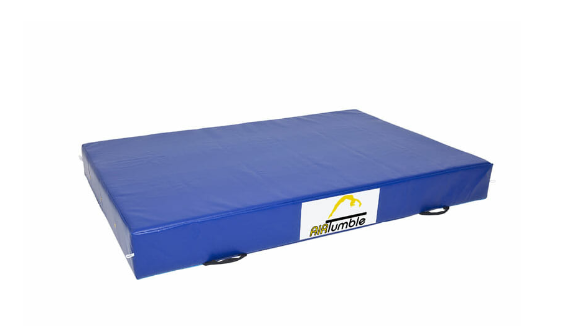
Athlete practicing flips on AirTumble crash mat for safe gymnastics training
4. Choosing for your level: beginner, intermediate, club
Let’s match spec to use case. Use the table below and examples to guide you.
| User / Goal | Ideal Spec | Reasoning | Supporting Gear |
| Beginner/child | 3–4 m length, 10–15 cm thickness | Compact, safer bounce, lighter | crash pad, small Gymnastics Bars, mini Gymnastics Beam |
| Intermediate/teenager | 5–6 m, 15–20 cm thickness | Enough runway for linking passes | adjustable Gymnastics Bars, foldable beam |
| Club/multiple users | 7–8 m+, ≥20 cm | Max durability and bounce | full crash zones, full bars & beam setup |
4.1 Home beginner example
A parent with a 5 m garage space might pick a 4 m × 1 m, 15 cm model. It’s light enough to roll up, gives a safe bounce, and fits the room. Use crash pads around edges and perhaps a small Gymnastics Bars set for conditioning drills.
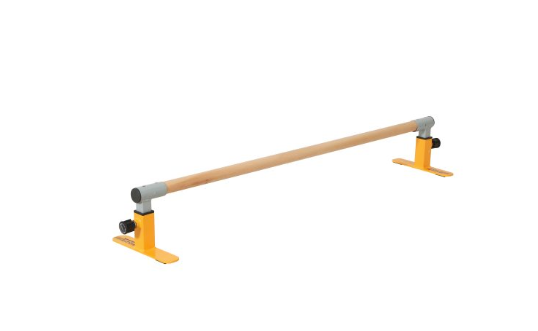
4.2 Intermediate/recreational user
Someone training serious tumbling might prefer 6 m, 20 cm. More runway, firmer bounce. Use a good electric pump. Add adjustable bars or a beam to expand the training surface control.
4.3 Club/coaching example
A gym or club might go for 8 m+ with 20-25 cm thickness, given high load. Reinforced builds, strong valves, and warranties matter most. Pair with full beam and bar stations for complete sets.
Real quote from a customer on the site:
“Bought this for my daughter’s 9th birthday! She absolutely loves it… easy to set up and put away, great quality.”
That shows what works, ease + quality.
Step-by-step buying checklist
Here’s your actionable path:
- Measure your available training space, leave 1–2 m bonus for run-off.
- Pick thickness according to your skill & user weight (10 cm up to 20 cm+).
- Inspect material & build (1000 Denier DWF, reinforced seams).
- Check pump & valve quality (electric pump, tight, durable valve).
- Plan safety features (crash mats, space, supervision).
- Review warranty & user reviews before committing.
“Train with more confidence, not guesswork.”
Pick wisely today so you don’t regret it later.
Train Strong, Land Safe – Your Promise
- Right Size- so you stay within bounds
- Right Feel- bounce matched to your growth
- Right Durability- built to last
From Specs to Practice: Time to Pick & Perform
You now have the tools to pick an air track that matches your space, skill, and goals, without guessing or overspending. Focus on size, thickness, material, and safety first. Use our 6-step checklist, and lean into reviews, warranty, and real-world user feedback.
If you’re ready, explore Air Tumble’s track ranges and see which spec fits you best. Inflate your confidence, not your risks.
FAQs
What size air track should I choose for home gymnastics?
Choose a track that fits your space but leaves extra clearance, 3–6 m is common for home use.
Is an air track safe for kids at home?
Yes, when inflated properly, placed on flat ground, and used with crash mats and supervision.
How firm should I inflate an air track?
Start with medium pressure. If you feel “bottoming out,” add air slowly. If landings feel stiff, release a little.
How do I repair a puncture?
Clean and dry the area, use patch + adhesive, press firmly and wait. Always carry a repair kit.
Can I use an air track outdoors?
Yes, but use a protective underlayer, clear debris, and avoid leaving it in direct sun for long durations.
How long do air tracks last?
With good materials and care, they last for years. Poor builds may degrade faster.



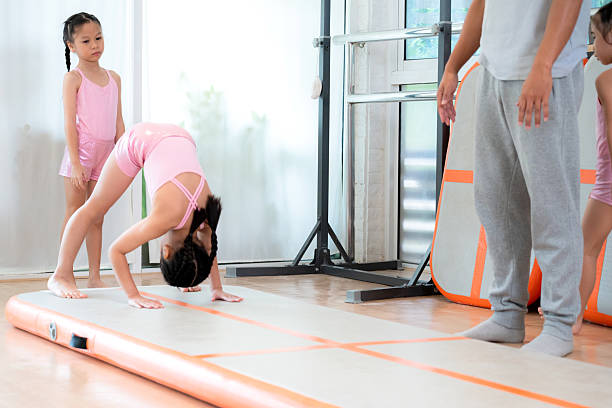
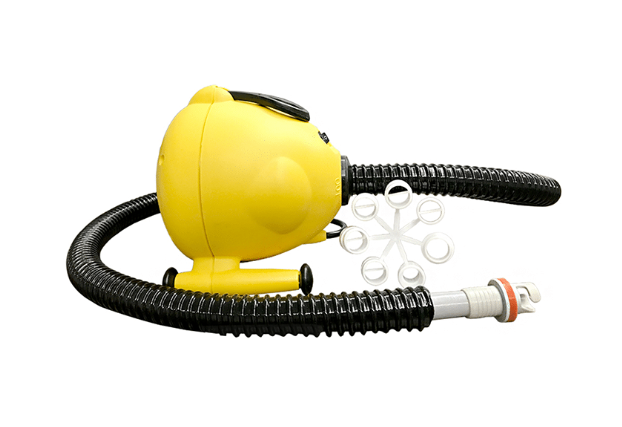


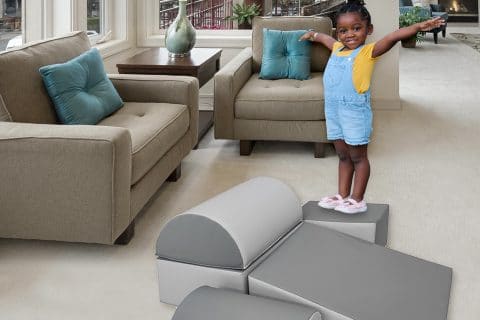
Leave a comment